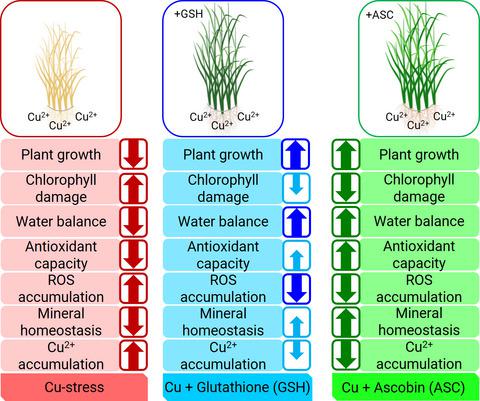当前位置:
X-MOL 学术
›
Plant Biol.
›
论文详情
Our official English website, www.x-mol.net, welcomes your feedback! (Note: you will need to create a separate account there.)
Comparative effects of ascobin and glutathione on copper homeostasis and oxidative stress metabolism in mitigation of copper toxicity in rice
Plant Biology ( IF 3.9 ) Pub Date : 2020-11-24 , DOI: 10.1111/plb.13222 M. Tahjib‐Ul‐Arif 1, 2 , A. A. M. Sohag 1 , M. G. Mostofa 3 , M. A. S. Polash 4 , A. G. M. S. U. Mahamud 5 , S. Afrin 2 , M. A. Hossain 6 , M. A. Hossain 1 , Y. Murata 2 , L.‐S. P. Tran 7, 8
中文翻译:

抗坏血酸和谷胱甘肽对减轻水稻铜毒的铜稳态和氧化应激代谢的比较作用
更新日期:2021-01-07
Plant Biology ( IF 3.9 ) Pub Date : 2020-11-24 , DOI: 10.1111/plb.13222 M. Tahjib‐Ul‐Arif 1, 2 , A. A. M. Sohag 1 , M. G. Mostofa 3 , M. A. S. Polash 4 , A. G. M. S. U. Mahamud 5 , S. Afrin 2 , M. A. Hossain 6 , M. A. Hossain 1 , Y. Murata 2 , L.‐S. P. Tran 7, 8
Affiliation

|
- Copper (Cu) pollution of agricultural land is a major threat to crop production. Exogenous chemical treatment is an easily accessible and rapid approach to remediate metal toxicity, including Cu toxicity in plants.
- We compared the effects of ascobin (ASC; ascorbic acid:citric acid at 2:1) and glutathione (GSH) in mitigation of Cu toxicity in rice.
- Plants subjected to Cu stress displayed growth inhibition and biomass reduction, which were connected to reduced levels of chlorophylls, RWC, total phenolic compounds, carotenoids and Mg2+. Increased accumulation of ROS and malondialdehyde indicated oxidative stress in Cu‐stressed plants. However, application of ASC or GSH minimized the inhibitory effects of Cu stress on rice plants by restricting Cu2+ uptake and improving mineral balance, chlorophyll content and RWC. Both ASC and GSH pretreatments reduced levels of ROS and malondialdehyde and improved activities of antioxidant enzymes, suggesting their roles in alleviating oxidative damage. A comparison on the effects of ASC and GSH under Cu stress revealed that ASC was more effective in restricting Cu2+ accumulation (69.5% by ASC and 57.1% by GSH), Ca2+ and Mg2+ homeostasis, protection of photosynthetic pigments and activation of antioxidant defence mechanisms [catalase (110.4%), ascorbate peroxidase (76.5%) and guaiacol peroxidase (39.0%) by ASC, and catalase (58.9%) and ascorbate peroxidase (59.9%) by GSH] in rice than GSH, eventually resulting in better protection of ASC‐pretreated plants against Cu stress.
- In conclusion, although ASC and GSH differed in induction of stress protective mechanisms, both were effective in improving rice performance in response to Cu phytotoxicity.
中文翻译:

抗坏血酸和谷胱甘肽对减轻水稻铜毒的铜稳态和氧化应激代谢的比较作用
- 农业用地的铜(Cu)污染是对作物生产的主要威胁。外源化学处理是补救金属毒性(包括植物中的铜毒性)的一种容易获得且快速的方法。
- 我们比较了抗坏血酸(ASC; 2:1的抗坏血酸:柠檬酸)和谷胱甘肽(GSH)在减轻水稻中铜毒性方面的作用。
- 遭受铜胁迫的植物表现出生长抑制和生物量减少,这与叶绿素,RWC,总酚类化合物,类胡萝卜素和Mg 2+的降低水平有关。ROS和丙二醛的积累增加表明铜胁迫植物的氧化胁迫。然而,ASC或GSH的施用通过限制Cu 2+的吸收并改善矿物质平衡,叶绿素含量和RWC来最小化铜胁迫对水稻的抑制作用。ASC和GSH预处理均可降低ROS和丙二醛的水平,并提高抗氧化酶的活性,表明它们在减轻氧化损伤中的作用。铜胁迫下ASC和GSH的作用比较表明,ASC在限制Cu 2+方面更有效。积累(ASC占69.5%,GSH占57.1%),Ca 2+和Mg 2+稳态,保护光合色素和激活抗氧化防御机制[过氧化氢酶(110.4%),抗坏血酸过氧化物酶(76.5%)和愈创木酚过氧化物酶(39.0)相比于GSH],水稻中ASC所占的百分比),GSH中的过氧化氢酶(58.9%)和抗坏血酸过氧化物酶(59.9%)比GSH更好,因此最终可以更好地保护经ASC预处理的植物免受铜胁迫。
- 总之,尽管ASC和GSH在诱导胁迫保护机制上有所不同,但它们均能有效改善水稻对Cu的植物毒性反应。


























 京公网安备 11010802027423号
京公网安备 11010802027423号